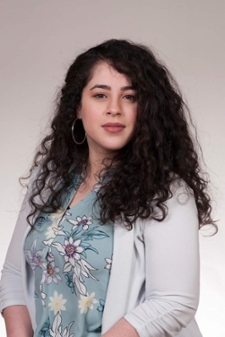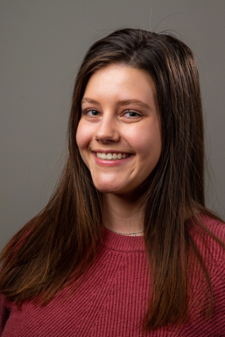
Hometown: Kansas City, Missouri
Major: Biology
Faculty Mentor: Shin Moteki
Mentor's Department: Chemistry
Funding Source: NSF
Increasing STEM Engagement in Underrepresented Minority Groups
The purpose of this research project is to acknowledge and encourage greater equity within the STEM fields of science, technology, engineering, and mathematics in a way that is aimed to reinforce and support minority students in the Midwestern United States in order to encourage economic growth. The number of African American PhD holders has remained unchanged in the last 26 years and has even decreased (~ 1-2%) among the Latino community. The US Department of Education declares that people of color continue to fall behind other groups. In 2017, although students of color made up 20% of the college population, barriers confirmed that only 9% secured degrees in STEM. These barriers range from a general lack of representation and mentorship, unequal opportunity, limited perception of potential career paths, disproportionate access to materials, all the way to the perpetual biases and stereotyping that begins early and continues on throughout a minority student’s career. All of which has proven to contribute to this increasing gap in education and marginal minority success in STEM professions. These facts prompted our research to emphasize the steps that can be taken to mitigate these barriers and encourage Missouri students from a variety of backgrounds to engage in STEM higher education. According to Missouri’s 2019 Equity Report, economists believe that higher levels of education contribute to overall employment opportunities which will promote economic growth and decrease dependency on state welfare programs by 91% if all high school graduates were able to obtain a bachelor’s degree. Most importantly, black and Latino students will be able to receive the support they deserve in order to excel and contribute to their communities in a major way.
 Maya Baughn
Maya BaughnHometown: Independence, Missouri
Major: Health Sciences
Faculty Mentor: Amanda Grimes and Joseph Lightner
Mentor's Department: Nursing and Health Studies
Funding Source: Department of Health and Human Services
Move More, Get More: A Physical Activity and Nutrition Intervention for Middle School Youth
One chronic health issue adolescents may experience is obesity. According to the Center for Disease Control and Prevention, in 2019 there was a 20.6% prevalence for obesity in individuals aged 12-19 in the United States. One possible solution for reducing the occurrence of chronic health issues like obesity is physical activity. Kansas City, Missouri (KCMO) was selected by the US Department of Health and Human Services as one of eighteen sites to deliver a physical activity and nutrition intervention to adolescents. Move More, Get More (formally known as Youth Engagement in Sports) is an initiative that targets students in grades 6-8 who attend select KCMO public middle schools. Within the first couple months of data collection, the COVID-19 pandemic occurred. Physical activity levels (in minutes) of the students enrolled decreased dramatically with the schools’ transition to online learning. The program has since been adopted to fit an online format where students meet multiple times a week for one hour live coaching sessions on Microsoft TEAMS with Kansas City Parks and Recreation and other fitness instructors. Approximately 100 students from Kansas City Public Schools have been served by this program since its implementation in spring 2020. Once a week, participants in the study have the opportunity to receive fresh produce from Truman Medical Center’s Mobile Market. This study aims to improve physical activity and nutrition in middle school students in order to improve overall health for marginalized youth with a particular focus on female youth.
 Adam Cardenas Sisk
Adam Cardenas SiskHometown: Blue Springs, Missouri
Major: Spanish
Faculty Mentor: Viviana Grieco
Mentor's Department: History
Funding Source: N/A
A Knowledge Graph for Managing and Analyzing Spanish American Notary Records
Spanish American notary records were written in script that was intentionally cryptic and it takes years of paleography training to become proficient in reading and analyzing their contents. Since we are fluent in Spanish and trained in paleography, we were able to use notary records as sources for our studies. Our research follows the changes in modern Spanish spelling and phonetics to show that modifications pioneered by prominent Spanish writers and poets transferred to the notarial scripts and focuses on how public notaries and the deeds they drafted promoted the expansion of trade and credit in seventeenth century Buenos Aires beyond the boundaries of family networks.
Projects were developed under an intercampus and interdisciplinary (History/Computer Science) collaboration led by Dr. Viviana Grieco (UMKC) and Dr. Praveen Rao (MU). They are developing a software system that will enable scholars to efficiently read, analyze, and find content in the seventeenth-century notary records housed at the National Archives in Argentina.This corpus has been digitized and its digital information can be modeled as a knowledge graph by applying deep learning and scalable knowledge management techniques. A knowledge graph models each page in this collection, their attributes, and the relationships between.
This tool will transform future historical and linguistic scholarship as it will make these documents accessible to broader audiences. Since advances in deep learning are transferable to other fields, this software could be used in the management of documentary collections available in Missouri.
 Ashley Cole
Ashley ColeHometown: Lee's Summit, Missouri
Major: Chemistry
Faculty Mentor: Shin Moteki
Mentor's Department: Chemistry
Funding Source: SEARCH Grant/NSF
Smart Catalysts - Green and Sustainable Synthetic Approach Mimicking Living Cells
Chemical manufacturing is one of the largest and diverse pattern industries in Missouri. Chemical manufacturing industries employ nearly 17,000 and are clustered in St. Louis and Kansas City, Missouri. Chemicals represent Missouri’s second largest foreign export (>$2.5 Billion) and are a major domestic export to other states. Over 375 establishments are developing chemicals for agriculture, pharmaceutical, industrial, and cleaning applications, among others. Catalysis is a process that accelerates chemical reactions which would otherwise be extremely slow. Enzymes are biological catalysts which transform many materials (food) into essential products critical for sustaining life. Outside of biological systems, catalytic processes are involved in the industrial chemical processing of over 80% of all manufactured products. The purpose of this research is to design and prepare artificial enzymes or “smart catalysts,” which are applicable toward one-pot multi-step reactions that mimic biological systems. As many chemical reactions occur efficiently within a living cell (one-pot) without isolation and purification processes, our one-pot process is an artificial version of chemical processing where multi-step chemical processes occur in a single reaction flask (artificial cell). In other words, our approach will drastically reduce harmful waste associated with chemical productions and reduce CO2 emissions by minimizing isolation/purification processes at manufacturing plants. Therefore, a significant contribution to green/sustainable production will be made through our research, and our product will be highly competitive in price through a reduction in manufacturing costs.

Hometown: Bronx, New York
Major: Biology
Faculty Mentor: Rachael Allen
Mentor's Department: Genetics, Development, and Evolutionary Biology
Funding Source: SEARCH Grant
Predator Avoidance Behaviors of Dubia Cockroaches
This study focuses on observing and analyzing the different behavioral patterns Dubia cockroaches (Blaptica dubia) use to avoid potential predation. There is considerable variation in terms of habitats occupied by insect groups and how they avoid detection by predators in those locations, including camouflage or taking cover. Documented strategies include burying themselves in substrate and otherwise hiding in tight spaces. This species has been shown to favor hiding in crevices and hollow spaces to avoid being detected. Additionally, Dubia cockroaches discriminated between colored-shelter options. Dubia cockroaches are economically beneficial because of their recently gained importance to the reptile food industry due to their high protein and calcium content. Because of their close taxonomic relationship between Dubia cockroaches and German cockroaches future work may shed light on ways to reduce impacts of this widespread household pest.
 Connor Flathers
Connor FlathersHometown: Independence, Missouri
Major: Biology
Faculty Mentor: Jeffrey Price
Mentor's Department: Genetics, Developmental, and Evolutionary Biology
Funding Source: SEARCH Grant
Promoting Better Sleep: Studying Eye Physiology at the Cellular Level in Fruit Flies
This research on mechanisms affecting circadian rhythms will assist in the understanding of sleep-related disorders including Insomnia, Narcolepsy, and Alzheimer’s disease. Understanding the circadian rhythm can lead to the development of treatments for these disorders, as well as mechanisms for changes in eye physiology. The circadian rhythm, which is produced by an internal biological clock and drives the sleep/wake cycle as well as changes in eye physiology, is driven by a nuclear accumulation of several proteins in the eyes. For this project, we are looking specifically at two proteins called Bride of Doubletime (BDBT) and Doubletime (DBT), as well as the Nuclear Localization Sequence (NLS) which controls the movement of DBT to the nucleus. We observe this by comparing overexpression of wild type DBT in eyes of Drosophila melanogaster (fruit flies) to overexpression of DBT with a mutated NLS. Prior work showed that mutated DBT NLS eliminates its interaction with BDBT. During our research, we showed that the NLS mutant does not downregulate or reduce BDBT foci, formed by aggregation of BDBT, at ZT19 (middle of the night). However, overexpression of wild type DBT does reduce these foci. Reductions of BDBT in the eye led to reduced movement of DBT to the nucleus during the day. Therefore, the DBT-BDBT binding event involving the DBT NLS is needed for movement of DBT to the nucleus and the daily reductions in BDBT.

Hometown: Monett, Missouri
Major: Music Education
Faculty Mentor: Lani Hamilton
Mentor's Department: Music Education
Funding Source: N/A
Comparisons of Support Among K-12 Music Teachers in Missouri and Kansas
The purpose of this study is to examine correlations between various personal/situational factors and music teachers’ perceptions of support received from administration, colleagues, and students’ parents. This descriptive study will help us better understand teachers’ perceptions of the music education environment in rural, urban, and suburban school locations as well as perceptions held by participants located across the Missouri/Kansas state line. We developed a survey for music teachers in the states of Missouri and Kansas, inquiring about participants’ demographic information, educational experiences, teaching history, future teaching plans, and perceptions of support. Results of the study suggest that state location alone does not seem to correlate with differences in perceived administrative, colleague, or parent support. Music teachers in rural, urban, and suburban school locations report similar levels of perceived administrative support, while urban teachers report lower levels of perceived parent support and rural teachers report lower levels of perceived colleague support. Additionally, nearly half of all participants reported that they considered their classrooms to be fully financially supported by their administration; those who indicated otherwise tended to report lower levels of administrative, colleague, and parent support. We asked these participants how much additional funding they would need to consider their classrooms fully financially supported, and teachers in urban school districts reported needing the least amount of additional funding. Overall results support the notion that unique factors determined by school location might play an important role in music teachers' perceptions of support.
 Rachel Moreno
Rachel MorenoHometown: Kansas City, Kansas
Major: Sociology and History
Faculty Mentor: Shannon Jackson
Mentor's Department: Sociology
Funding Source: N/A
Internet of Things (IoT) and Public Space: The Case of ShotSpotter
Devices, such as Fitbit, smart watches, etc., have become an indistinguishable part of our daily lives. The digital platforms, algorithms, and networks that support direct connections among such devices, known as the Internet of Things (IoT), is also being integrated with urban infrastructure leading to development trends such the Smart City. The purpose of the Smart City is to help public officials and innovators respond to the needs of residents more efficiently and effectively by using IoT to gather data about user behavior and the urban environment. The belief is that devices and more automatic data collection will create a safer and more efficient city. My research focuses on ShotSpotter (SST), an IoT gunshot detection system that uses acoustic sensors to locate and determine gun fire. ShotSpotter is one of many publicly deployed systems that is privately owned. Its integration with public infrastructure further blurs the boundaries separating public and private decision-making. I examine SST as part of a larger trend that shifts control of public space away from citizens, city residents, and publicly accountable officials. Through scholarly literary review and interviews with community stakeholders in Kansas City, Missouri, I examine the relationship between IoT devices and public space to consider the larger impact of this trend on the rights of citizens. This case study will demonstrate that while IoT technologies are believed to solve urban problems, they change the ways problems are defined while removing accountability from the use of public information.
 Anthony Reddick
Anthony ReddickHometown: Hallsville, Missouri
Major: Chemistry
Faculty Mentor: Jeffrey Price
Mentor's Department: Genetics, Developmental and Evolutionary Biology
Funding Source: SEARCH Grant
Promoting Better Sleep: Studying Eye Physiology at the Cellular Level in Fruit Flies
This research on mechanisms affecting circadian rhythms will assist in the understanding of sleep-related disorders including Insomnia, Narcolepsy, and Alzheimer’s disease. Understanding the circadian rhythm can lead to the development of treatments for these disorders, as well as mechanisms for changes in eye physiology. The circadian rhythm, which is produced by an internal biological clock and drives the sleep/wake cycle as well as changes in eye physiology, is driven by a nuclear accumulation of several proteins in the eyes. For this project, we are looking specifically at two proteins called Bride of Doubletime (BDBT) and Doubletime (DBT), as well as the Nuclear Localization Sequence (NLS) which controls the movement of DBT to the nucleus. We observe this by comparing overexpression of wild type DBT in eyes of Drosophila melanogaster (fruit flies) to overexpression of DBT with a mutated NLS. Prior work showed that mutated DBT NLS eliminates its interaction with BDBT. During our research, we showed that the NLS mutant does not downregulate or reduce BDBT foci, formed by aggregation of BDBT, at ZT19 (middle of the night). However, overexpression of wild type DBT does reduce these foci. Reductions of BDBT in the eye led to reduced movement of DBT to the nucleus during the day. Therefore, the DBT-BDBT binding event involving the DBT NLS is needed for movement of DBT to the nucleus and the daily reductions in BDBT.

Hometown: Kansas City KS
Major: History and Spanish
Faculty Mentor: Viviana Grieco
Mentor's Department: History
Funding Source: N/A
A Knowledge Graph for Managing and Analyzing Spanish American Notary Records
Spanish American notary records were written in script that was intentionally cryptic and it takes years of paleography training to become proficient in reading and analyzing their contents. Since we are fluent in Spanish and trained in paleography, we were able to use notary records as sources for our studies. Our research follows the changes in modern Spanish spelling and phonetics to show that modifications pioneered by prominent Spanish writers and poets transferred to the notarial scripts and focuses on how public notaries and the deeds they drafted promoted the expansion of trade and credit in seventeenth century Buenos Aires beyond the boundaries of family networks.
Projects were developed under an intercampus and interdisciplinary (History/Computer Science) collaboration led by Dr. Viviana Grieco (UMKC) and Dr. Praveen Rao (MU). They are developing a software system that will enable scholars to efficiently read, analyze, and find content in the seventeenth-century notary records housed at the National Archives in Argentina.This corpus has been digitized and its digital information can be modeled as a knowledge graph by applying deep learning and scalable knowledge management techniques. A knowledge graph models each page in this collection, their attributes, and the relationships between.
This tool will transform future historical and linguistic scholarship as it will make these documents accessible to broader audiences. Since advances in deep learning are transferable to other fields, this software could be used in the management of documentary collections available in Missouri.
 Shanya San
Shanya SanHometown: Kansas City, Missouri
Major: Biology, Chemistry, and Psychology
Faculty Mentor: Wai-Yim Ching
Mentor's Department: Physics and Astronomy
Funding Source: NSF
The Intercalation of Cancer Drug Doxorubicin in Various DNA Sequences
Doxorubicin is a cancer drug that treats a wide range of cancers namely leukemia, lymphoma, and cancers in internal organs, tissues, and skins. This drug damages the cancerous cells and prevents them from growing and reproducing. Previous studies found that when the doxorubicin is intercalated, the DNA of the cancer cell forms a complex preventing the enzyme topoisomerase-II from performing its function of replicating the DNA, in this instance the cancerous DNA. However, blocking the topoisomerase-II enzyme results in the cancer cell to kill itself. It is important to note where this drug is added into the DNA. DNA has four base pairs that create an abundant number of sequences. Finding the most effective base pair, for the cancer drug to be inserted, can efficiently block the DNA replication and translation of the cancer cell. Consequently, this can guide in finding the strongest topoisomerase inhibitors to force the cancer cell to its end. Finding the best insertion site can more effectively prevent the spread of the cancer while also decreasing the side effects of the drug. This research project focuses on studying different DNA sequences that would generate the highest yield for the insertion of doxorubicin. This is determined by analyzing chemical and physical properties of the cancer drug incorporated into the various studied base pairs in the DNA. This understanding can guide the advancement and modification of drug designs intercalating into DNA sequences.

Hometown: Farmington, Missouri
Major: Psychology and Sociology
Faculty Mentor: Erin Hambrick
Mentor's Department: Psychological Sciences
Funding Source: SEARCH Grant
Protective Factors and Their Effect on Attachment in Children
Attachment quality impacts a child's stress regulation, adaptability, and resilience. I examine the role of protective factors in promoting attachment in a sample of children who have experienced at least one adverse experience related to attachment. To do this, we will utilize data from a study of relational capacities in typically- developing (not currently receiving any mental health or developmental services and not having an intellectual disability) preschoolers. Our independent variables for this project are the child's protective factors, and the dependent variable is level of attachment. These variables are obtained from the study's caregiver surveys and interviews. We hypothesize that protective factors may have buffered children's response to adversity. This would support the idea that though adverse childhood experiences are common, there is hope for resilience.
 Shreya Suri
Shreya SuriHometown: Joplin, Missouri
Major: Biology and Environmental Science
Faculty Mentor: Fengpeng Sun
Mentor's Department: Earth and Environmental Sciences
Funding Source: SEARCH Grant
Cool Roofs' Potential to Mitigate Heat-Induced Health Risks in the Kansas City Metro Area
An urban heat island (UHI) refers to an urban area that is significantly warmer than surrounding rural and suburban regions due to human activity, sparse vegetation, and the use of heat-retaining materials in infrastructure. This increase in temperature is associated with an increased risk of heat stress and heat-related illness, such as heat stroke. A potential solution to mitigate the UHI effect in urban areas is the implementation of cool roofs, which absorb less heat and reflect a greater percentage of solar radiation compared to traditional roofs due to their reflective color and/or material (e.g. solar reflective shingles or tiles). In addition to reducing local air temperatures, cool roofs can improve indoor comfort, reduce energy costs associated with air conditioning, and extend roof life due to decreased heat absorption. In this study, three common biometeorological heat stress indices were used to evaluate the effectiveness of cool roofs in mitigating UHI-induced heat stress in the Kansas City metropolitan area. Output data from a series of high-resolution regional climate model simulations were used to generate spatial maps and highlight differences in the biometeorological indices after the implementation of cool roofs in the area. According to all three indices, a substantial reduction of heat stress after cool roof implementation was found in the core of the downtown metropolitan area. These modeling and analysis results suggest that the implementation of cool roofs will efficiently reduce UHI-induced heat stress in Kansas City.

Hometown: Kansas City, Missouri
Major: Environmental Science
Faculty Mentor: Jejung Lee
Mentor's Department: Earth and Environmental Sciences
Funding Source: SEARCH Grant
Real-time Prediction of Water Quality in Kansas City Urban Lakes
The purpose of this project is to develop a cost-effective and reliable device to predict the water quality of a given body of water. Our device will grant local governments the ability to monitor lakes in a budget-friendly way. Lakes are often a focal point for communities, so any risks to human health, such as E. Coli and harmful algae, must be monitored. This device predicts the water's quality based on specific parameters known to be linked to health risks, so that local governments and communities can act swiftly and appropriately. Phase one of this project includes building a cost-effective prototype that can return values similar to lab-grade sensors and deploying the prototype on Smithville Lake to test its effectiveness in the field.
 Emily Wesley
Emily WesleyHometown: Elkhart, Kansas
Major: Biology
Faculty Mentor: Scott Hawley and Katie Billmyre
Mentor's Department: Stowers Institute
Funding Source: Stowers Institute
Keeping It Together: Unlocking the Causes of Infertility and Genetic Disorders
Meiosis is a complex process that most organisms use to generate germ cells (eggs and sperm) for sexual reproduction. Successful meiosis requires the correct amount of genetic material (i.e. chromosomes) to be packaged in each egg or sperm. A failure in this process results in aneuploidy (the incorrect number of chromosomes), which can cause genetic disorders such as Down syndrome, Klinefelter syndrome, infertility, or miscarriage. There are many steps during meiosis that ensure that the proper number of chromosomes are inherited. One key step is the establishment and maintenance of a multi-protein complex known as the synaptonemal complex (SC) between chromosomes. This structure allows chromosomes to be paired together and moved to the correct germ cell. We use the fruit fly to study multiple aspects of the synaptonemal complex. Currently, not much is known about how SC formation is regulated in flies. Previous work in yeast and mice suggest that SC formation is impacted by the modifications made by cyclin-dependent kinases (CDKs). CDKs are well-known for their role in the generation of new cells, but they are also known to regulate meiosis. Here we removed three predicted CDK binding sites in an SC protein to observe if SC formation was impacted by the loss of CDK regulation. Interestingly, we found that deleting these sites prohibited the SC from fully forming. This suggests that CDK binding sites are important for building and maintaining the SC. Additional work is needed to see if other aspects of meiosis are affected. These results further our understanding of how the SC is assembled and maintained. Understanding how chromosomes are separated into germ cells is critical to furthering our ability to treat infertility and chromosomal disorders.